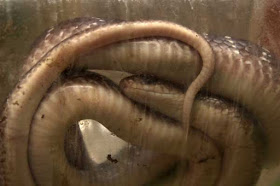
I was surprised. I never imagined it to be a krait and there it was a common Indian krait waiting behind the bricks. This is my first krait sighting. I quickly told the people to get a strong stick and get some more light. I secured the head with stick and was about to catch the snake, suddenly a over-enthusiast man showed up with a big log in his hand. He didn’t hear anybody and straight tried to kill the snake. I was in an awkward situation. With one hand I was holding the stick with which I had secured the head of the snake and with the other hand I was trying to cover the blows made with the big log. The most terrifying thing was that the snake is no ordinary snake, it is the most venomous snake of asia. After a few blows the man paused for a second and I quickly captured the snake and started walking straight to my house. I put it in a plastic jar and kept it in a secure place.

Common Indian krait or Bungarus caeruleus is a nocturnal snake. In the daytime it is a very lazy and timid snake but at night a sharp contrast in behaviour can be seen. It becomes very active, alert and dangerous. In the daytime it generally rests in termite mounds, rodent burrows, stacks of bricks, rubbles or even inside household items like rolled up carpets. This snake is so well adopted in various habitats that it is found in almost all of India except Kashmir and Arunachal Pradesh. It is mainly found in fields, low scrub jungles and even in marshy lands. It is also found near human habitation and often enters inside houses. This particular behaviour makes it more dangerous. Some time people get bitten unknowingly when they are asleep. Their bite is not as painful as cobra or viper bite but it is far more virulent than the two (it is 15 times more potent than the cobra). Its venom is both neurotoxic and heamotoxic. It is the MOST VENEMOUS snake of India. Bite from this snake must be treated at hospital with antivenom serum. Otherwise death will come in 5 to 12 hours. Symptoms are like cobra bite, drooping eyelid, severe abdominal pain, vomiting and respiratory problem. Usually the cause of death is respiratory failure.

It is a cannibalistic snake. It usually eats other snake often of the same species. It also eats frogs, lizards and mouse. It attains a maximum length of 1.73 m but average size is 1.2m. the specimen i caught was around 1m in length. May be due to their cannibalistic nature at the time of mating, they first carry out an examination of each other and then settles down together. Mating occurs in February- march. Kraits also stay with the eggs like the cobras.
After a few days I planned to release the Krait. But finding a suitable place was a real headache. There was no suitable place remote enough to release the snake. I had to travel 30km to find a place for the releasing. every day more and more lands are being converted into farmland, commercial land or residential area. Snakes and other life forms are finding it hard to find an unused patch of land which they can use as their safe refuse.

**One interesting fact I would like to mention. On my journey of 60 km, I found atleast 14 dead snakes, all are road kill, run over by cars. 6 of the snakes are olive keelback water snake, 4 are chekered keelback water snake, 2 are buff stripped keelback land snake, 1 is a rat snake and the other one was not in identifiable condition.

























